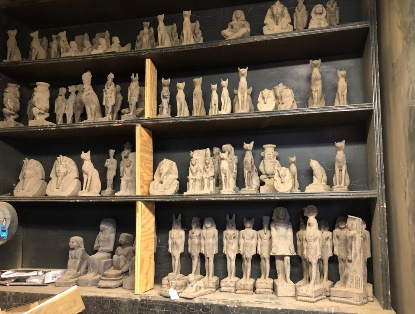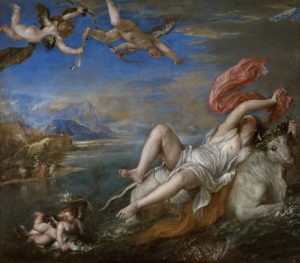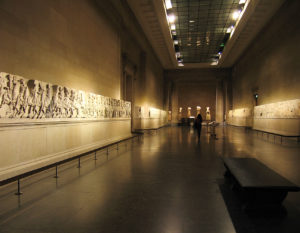COMMENTS ON THE ART MARKET
September Hours
And A Note From The Father & Mother Of The Bride
For the month of September, the gallery will be open Tuesday - Friday, with the following exception:
Alyssa's wedding 'party' will take place on August 29th - something she and Adam missed last summer since they were married in our backyard with just nine people in attendance. After that, we all wanted a break, so the gallery will be closed from August 27th through September 6th.
Of course, we will still be available by email and telephone ... so feel free to contact us if you have any questions.
We also want to take this time to wish everyone a safe and relaxing Labor Day weekend.
____________________
A New Little Helper

As many of you might know, about 4 years ago Lance decided to add a member to the family -- Travis (a cross between a Pomeranian and Husky). He has been 'working' at the gallery for more than 3 years now. Well, Alyssa was getting jealous, so a couple of weeks ago she decided to add yet another member to the family -- Ollie (a cross between a Yellow Lab and Border Collie). Ollie is now working, under, and at times on top of, Travis. What fun it is to watch the two go at it all day long!
____________________
Stocks & Crypto
By: Lance
We’re wrapping up August a bit early for this newsletter, so the following is as of market close on the 27th; and we’re at lofty numbers across the board. Both the S&P and Nasdaq hit intraday records on Friday, and the Dow set a fresh record back on the 16th. While the Dow was up almost 1% for the month, the NASDAQ and S&P far outpaced it, gaining nearly 2.8% and 2.2%, respectively. Expectations are this red-hot summer will start to cool as we move into the fall, between concerns over the Delta variant and waning momentum from the reopening we saw just a few months ago. One worrisome figure is US consumer sentiment, which roughly translates how optimistic consumers feel about their personal finances and the state of the economy – that index collapsed earlier this month again, hitting its lowest level in a decade. Either way, it would probably be unreasonable to expect the gains we are seeing to continue.
Both the Pound and Euro saw minor fluctuations relative to the US Dollar… The Pound started the month at $1.389 and closed at $1.375, while the Euro opened at $1.187 and finished off at $1.18. Gold prices dipped in the middle of the month but reversed course and pretty much finished where it started - $1,817.10 to $1,820.50, a $3 increase. Crude experienced some volatility – much of the concern seems to be around lesser demand just as an increased supply is reaching the market; futures dipped more than $10 (15%), before reversing the final week of August to close at $68.67.
August was kind to the crypto kids… seems like everything is on the way up again, for now. Bitcoin is back to flirting with $50K, Ethereum is well over $3K, and Litecoin has its sights set on $200; I don’t get teary-eyed anymore when I open my Coinbase app. Dogecoin also popped again… granted it's still well below the crazy levels we saw a few months ago – it’s currently in the $0.30 range, which I am very ok with.
Finally, some personal holdings… Airbnb (ABNB – month +6.3%); American Well Corporation (AMWL – month -7.4%); Aurora Cannabis Inc. (ACB – month -0.7%); Beyond Meat, Inc. (BYND – month -1.3%); Blink Charging Co. (BLNK – month -8.9%); Churchill Capital Corp IV (CCIV is now trading as Lucid Group LCID -12.6%); Canopy Growth Corp. (CGC – month -10.1%); Cronos Group Inc. (CRON – month -13.7%); FuelCell (FCEL – month -1.5%); Fisker Inc. (FSR – month -13%); Nikola Corp (NKLA – month -14.15%); QuantumScape Corp (QS – month -3.7%); Under Armor, Inc. (UAA – month +12.9%); and Zomedica Corp. (ZOM –month +2.8%). At least they weren’t all losers again… what a low bar we’ve set.
____________________
The Dark Side
By: Alyssa, Howard & Lance
Big City Scammer Gets Nabbed

Earlier this month, New York antiquities dealer Mehrad Sadigh was arrest and charged with scheming to defraud, grand larceny, criminal possession of a forged instrument, forgery and criminal simulation. Mehrad has pleaded not guilty to all charges.
After being alerted to the matter, undercover agents purchased two ‘antiquities’ for $4000 each. Once confirmed that they were not as reported, investigators went to the gallery and found hundreds of fake artifacts on display. Even more troubling was the discovery of thousands more in other rooms and the tools needed to make the newly created items look old.
According to prosecutors, his actions had been going on for years. One can only imagine how many people have been taken by the scam, not to mention how much money was lost. Manhattan district attorney Cyrus Vance Jr. stated that “For many years, this fake antiquities mill based in midtown Manhattan promised customers rare treasures from the ancient world and instead sold them pieces manufactured on-site in cookie-cutter fashion.” The gallery’s website states that “All of our antiquities are guaranteed authentic.” I guess they were all authentic – authentic fakes!
Will The Jewels Ever Be Recovered?
 Back in 2019, we reported on a jewelry theft in Dresden. A group of thieves started a fire that destroyed an electricity box near the Grünes Gewölbe (Green Vault – a museum founded in 1723) which, in turn, affected the security system. The group of six criminals then broke in through a window, smashed the glass cases, and stole about $1.2 billion worth of jewelry.
Back in 2019, we reported on a jewelry theft in Dresden. A group of thieves started a fire that destroyed an electricity box near the Grünes Gewölbe (Green Vault – a museum founded in 1723) which, in turn, affected the security system. The group of six criminals then broke in through a window, smashed the glass cases, and stole about $1.2 billion worth of jewelry.
Between November 2020 and May 2021, Germany carried out a series of raids (18 in all) involving 1,600 police officers. These operations led to the arrest of five suspects, all of whom are still in police custody. On August 19th, 2021, a 23-year-old man was arrested in connection with the heist and charged with theft and arson. It seems like they now have the entire gang behind bars.
It will be interesting to see if the stolen jewels are recovered.
Guess Everyone Wants A Van Gogh – I Know I Do!
 On August 4th, Raffaele Imperiale (one of Italy’s most notorious crime bosses), was arrested in Dubai. The Italian government had been searching for him since 2016 for alleged money laundering and international drug trafficking as part of organized crime activity.
On August 4th, Raffaele Imperiale (one of Italy’s most notorious crime bosses), was arrested in Dubai. The Italian government had been searching for him since 2016 for alleged money laundering and international drug trafficking as part of organized crime activity.
Now we will roll back to 2002, when news emerged that thieves broke into the Van Gogh Museum in Amsterdam and stole two paintings – View of the Sea at Scheveningen and Congregation Leaving the Reformed Church in Nuenen. Well, when Italian authorities seized property owned by Imperiale in 2016, they discovered the two paintings behind a bathroom wall. That sounds like a scene from a movie.
I found it very interesting that just a few months ago, Imperiale was interviewed by the Neopolitan newspaper Il Mattino. During the interview, he denied involvement in the actual theft but stated that “I bought them directly from the thief, because the price was attractive. But most of all because I love art.’’
Sotheby’s: Buy At Your Own Risk, Wo Do Not Sell At Our Own Risk
Well this is certainly an interesting one… as I am sure many of you know, buying at auction is inherently risky – condition issues may not be disclosed, there may be gaps in provenance which obscure proper ownership, and works may be inauthentic altogether. When those issues arise, there is usually very little recourse for the buyer – most auction houses operate with a “buy at your own risky” policy, where it is up to you to do your due diligence and know what you are buying. That makes it very difficult for some to have full confidence in the auction system; after all, they are supposed to be considered “experts” yet mistakes are still made.
Case in point, Sotheby’s is suing a Florida couple after it was uncovered that they consigned and sold fraudulent works through their auction said to be by artist Diego Giacometti. By no means is the couple innocent – they seemingly knew the works were not authentic and went through quite a bit of trouble to conceal that fact.
Fredric and Bettina Thut, the accused Florida couple, went as far as creating fake provenance records and paperwork; that was seemingly enough to fool one of the most prestigious auction houses in the world. You would think an organization such as Sotheby’s would do a bit of research of their own before selling works for more than $1M, but clearly they have other prioritie$. Nevertheless, it is a bad look so Sotheby’s is now going after the Florida couple for $7M!
When confronted with the fact, it is said their experts reacted in disbelief, pointing to the “strength of the provenance documents.” It doesn’t exactly take an expert to read provenance, so perhaps there should be a higher bar set in an effort to protect the buyers. Just think of how many fraudulent works passed through an auction and were never questioned – many of them still hanging among private collections, unbeknownst to the owner.
It’ll be interesting to see how this one shakes out, as the couple is reportedly refusing to hand over the proceeds. We’ll see what the judge says…
Gulbenkian, Case Closed!
Tales From the Dark Side: UPDATE
In two previous posts, we covered the criminal activities of Angela Gulbenkian. See here and here for a refresher.
Gulbenkian has been held in a Lisbon jail since December 2020 after evading UK authorities. Her trial has finally been settled as she was sentenced to three and a half years in prison minus the time she has already served. Gulbenkian married into a wealthy Russian family, which allowed her to gain the trust of more reputable individuals in the art world.
While pleading guilty to art fraud, her defense, or lack thereof, explained how Gulbenkian had the “best and honest intentions,” but, “the temptation was just too great,” once the money hit her account. After brokering a $1.3 million deal for a Yayoi Kusama yellow pumpkin, she blew the proceeds on “a £25,000 ($34,650) Rolex watch, £56,000 on artwork and a private jet flight. Her total expenditure between April 2017 and January 2018 was more than £1 million,” and ultimately never delivered the work.
____________________
Really?
By: Amy
To Shill, Or Not To Shill, That Is The Question!
 As you know, I have been reporting for years now on the prices of trading cards and how crazy the auction prices have gotten; now, it seems that all may not be as it appeared. Last week the news broke that PWCC, one of the largest auctioneers of trading cards, has had its selling privileges restricted on eBay for shill bidding. Shill bidding (a form of fraud) is when someone artificially increases the price during an auction; this can happen by the seller enlisting the help of friends, family, or associates to bid on an item without the intent to buy it. Recent reports claim that individuals (possibly employees) associated with the trading card auctioneer placed bids to drive up prices.
As you know, I have been reporting for years now on the prices of trading cards and how crazy the auction prices have gotten; now, it seems that all may not be as it appeared. Last week the news broke that PWCC, one of the largest auctioneers of trading cards, has had its selling privileges restricted on eBay for shill bidding. Shill bidding (a form of fraud) is when someone artificially increases the price during an auction; this can happen by the seller enlisting the help of friends, family, or associates to bid on an item without the intent to buy it. Recent reports claim that individuals (possibly employees) associated with the trading card auctioneer placed bids to drive up prices.
It is believed that PWCC generated $200 million in sales last year through the eBay platform. With the removal of close to 18,000 items listed by PWCC, there will be a lot of room for competitors to jump in, although PWCC will launch monthly premier auctions on their own site – I’m sure everyone will trust that.
Of course, PWCC claims that they have done nothing wrong and plan on fighting the allegations, but this is not the first scandal for the auctioneer. The FBI has been investigating PWCC since 2019, which involves allegations that they have been ‘trimming’ cards to increase the grading, which effectively would increase interest and prices on the trading card. If any or both allegations are proven to be accurate, I believe they could seriously damage the collectible trading card industry.
 On somewhat of another note, a couple of weeks ago, a T206 Honus Wagner baseball card sold for a record-setting $5.5M ($6.6M including the premium). The previous record was held by a 1952 Mickey Mantle card that sold for $5.2 this past January, and that price was matched in April when a LeBron James card sold. PWCC brokered the sale for the last two cards but did not sell the Honus Wagner card; that was sold by Robert Edwards Auctions, which specializes in sports memorabilia.
On somewhat of another note, a couple of weeks ago, a T206 Honus Wagner baseball card sold for a record-setting $5.5M ($6.6M including the premium). The previous record was held by a 1952 Mickey Mantle card that sold for $5.2 this past January, and that price was matched in April when a LeBron James card sold. PWCC brokered the sale for the last two cards but did not sell the Honus Wagner card; that was sold by Robert Edwards Auctions, which specializes in sports memorabilia.
____________________
The Art Market
By: Howard & Nathan
I am very pleased to report, that the public auction market was very quiet this month. So quiet, that we did not cover any sales ... hallelujah! That was so nice. I am sure that the action will start up by mid-September, so stay tuned.
We are also pleased to report that our nephew, Nathan Scheer, will be working with us for a few months. Nathan graduated from Elon University in 2019 with a Bachelor of Arts degree in History and International Studies, going on to the University of Chicago, where he graduated with a Master of Arts degree in Social Sciences. He loves to do research and write. His most recent blog posts (or should I say articles) are featured below:
Double-Theft: Nazi Art Loot In The 21st century
By: Nathan
 Last Friday, August 20th, the Jewish Museum in New York opened its latest exhibit, called “Afterlives”. It shows more than 50 works by Picasso, Chagall, Cézanne, Courbet, and others, telling the stories of their restitution after being stolen from Jewish owners during the Holocaust. One of the exhibit’s centerpieces is Girl in Yellow and Blue with a Guitar by Henri Matisse which, after being stolen from the French Jewish art dealer Paul Rosenberg, was found in the personal collection of Hermann Göring, the commander of the Nazi air force. The cause of returning art stolen by the Nazis has gotten a good deal of attention recently. Historical accuracy aside, popular films like The Monuments Men (2014) and Woman in Gold (2015) have shown the lengths that some will go to either reclaim or keep their hands on pieces of art.
Last Friday, August 20th, the Jewish Museum in New York opened its latest exhibit, called “Afterlives”. It shows more than 50 works by Picasso, Chagall, Cézanne, Courbet, and others, telling the stories of their restitution after being stolen from Jewish owners during the Holocaust. One of the exhibit’s centerpieces is Girl in Yellow and Blue with a Guitar by Henri Matisse which, after being stolen from the French Jewish art dealer Paul Rosenberg, was found in the personal collection of Hermann Göring, the commander of the Nazi air force. The cause of returning art stolen by the Nazis has gotten a good deal of attention recently. Historical accuracy aside, popular films like The Monuments Men (2014) and Woman in Gold (2015) have shown the lengths that some will go to either reclaim or keep their hands on pieces of art.
Despite this, battles over art ownership continue. The most recent case that made news is the fight over a 1764 Bernardo Bellotto cityscape called Marketplace at Pirna, currently hanging in the Museum of Fine Arts in Houston, Texas. The painting was once owned by a Jewish department store owner from Hamburg named Max Emden, who also owned two other works by the same artist. In 1938, Emden sold these three paintings to an art dealer working on behalf of the German government. The Nazis wished for the Bellotto cityscapes, among hundreds of thousands of other artworks, to be displayed in the planned Führermuseum in Linz, Austria. At the end of the Second World War, Emden’s paintings were confiscated by the Allied Forces in their search for Nazi loot. Two were returned to the German government, while the third, Marketplace at Pirna, was mistakenly given to the Dutch government. It had apparently been confused with a Bellotto painting of the same name previously owned by an Amsterdam resident. The Dutch government gave the painting to its listed owner, who then sold it to the New York art collector Samuel Kress in 1952. Then, in 1961, Kress donated his collection, including Marketplace at Pirna, to the Museum of Fine Arts in Houston.
In 2019, Germany’s Advisory Commission returned their two Bellotto paintings to Emden’s descendants because the original sale “was not undertaken voluntarily but was entirely due to worsening economic hardship” brought about due to restrictions on German Jews. The Houston museum, however, maintains that Emden sold the paintings voluntarily, allowing them to keep Marketplace at Pirna in their galleries. While European institutions have recognized their moral responsibility to return stolen artworks to the heirs of Holocaust victims, it seems that American museums and galleries like Houston’s Museum of Fine Arts have zero shame in putting forth an argument that boils down to “No one can make us give it back, therefore we won’t”. Gary Tinterow, the director of the museum, has stated outright that different standards apply to European governments and art institutions because of their direct culpability in anti-Semitic persecution. American museums, therefore, have no such moral obligation, instead being guided by “centuries of property law”. Robert M. Edsel, the chairman of the Monuments Men Foundation, has understandably described the museum’s rationale as “legalistic”. Furthermore, art and cultural heritage lawyer Leila Amineddoleh has also spoken out against the museum’s rationale. “U.S. museums and European bodies are not held to different standards because no entity, governmental or otherwise, should be acquiring stolen works.”
The museum’s legalistic modus operandi is not uncommon. David Rowland, who has represented the heirs of Holocaust-era art theft victims, has observed that American museums “are reverting to strictly legal approaches to claims”. While the Houston museum maintains that Max Emden had sold his paintings legally and without duress, they have also put forth the argument that the painting in their possession was never owned by Emden at all. The provenance section of their webpage on the painting once recently included Emden, but now has omitted his ownership from the record. They now argue that their Marketplace at Pirna is the one that was meant to be returned to Amsterdam instead of Emden’s painting. However, the inventory number on the frame demonstrates that this statement is false.
The Emden case comes at a time when art restitution is becoming increasingly difficult. Just last week, a new law in Poland sets a 30-year statute of limitations on stolen property allegations. This renders all Nazi art loot claims completely worthless at the legal level, including thousands of cases that have been under litigation for years. While Polish citizens seeking the return of their family’s art can no longer do so (for now, at least), the Emden family has yet to take legal action. It appears that the courts are the only place where the Houston museum will be made to relinquish their claim since the museum’s leadership seems to be unmoved by any sense of moral obligation. Their actions also appear to violate the code of Ethics, Standards, and Professional Practices of the American Alliance of Museums, which clearly states that a “museum’s responsibility to practice ethical stewardship is paramount” when it comes to looted art of any kind, particularly that which was stolen by the Nazis.
Even after seventy-five years, how often and how emphatically must people be reminded? How difficult can it be to do the right thing and quit it with the technicalities? Being stubborn and insufferably tone-deaf only adds insult to a very old injury which many still feel the effects of today. Being forced to do the right thing after initially resisting does not make you seem principled or restrained. It comes across as cold, inconsiderate, and greedy. By denying the Emden family’s claim, even after the questionable circumstances of the work’s sale were revealed, the museum is essentially stealing the painting a second time. And if the restitution went underway, would it really be such a great loss? The Houston Museum of Fine Arts already has an impressive collection, with works from Van Gogh and Cassatt all the way to O’Keeffe and de Kooning. But Bellotto’s Marketplace at Pirna is not exactly as recognizable as the works by these other artists. The case of Gustav Klimt’s Portrait of Adele Bloch-Bauer I, as shown in the 2015 film Woman in Gold, was a very different matter. Klimt was a prolific artist in turn-of-the-century Vienna, with the portrait serving as one of his most recognizable works when it was hanging in the Belvedere Gallery. But Marketplace at Pirna is not a portrait by Klimt. Before the Emden family made their claim, it was just an inoffensive painting of a town in Saxony by an artist many outside of art circles probably hadn’t even heard of. Will the people of Houston line up around the block to be able to see Bellotto’s canvas, as the Viennese had done before Klimt’s paintings left the country? Will art critics call on the museum to buy the painting from the Emden family, as the Austrian people had done, so that Houston will not be deprived of its pride? I think we all know the answers to these questions. Therefore, what harm could possibly be done, other than that which the museum has already done to its own reputation? What is so difficult?
Titian’s Women: Applying Modern Social Norms To The Renaissance
 In 1896, Boston socialite and art collector Isabella Stewart Gardner purchased Titian’s Rape of Europa from the Earl of Darnley. Bought for $100,000 (or about $3.2 million today), it was considered the museum’s greatest painting in an American collection. For many experts, The Rape of Europa is still the greatest Renaissance work in the United States. It was created in 1562 as the last installment of a series of six paintings commissioned by the King of Spain, Philip II. They are commonly referred to as Titian’s poesie, or poetry transferred to the canvas. The collection of works was only together for about 17 years, as one of them was given as a gift to one of the king’s advisors in 1579. Two of them are now in London: Danaë at the Wellington Museum, while Perseus & Andromeda sits in the Wallace Collection. Two others, Diana & Callisto and Diana & Actaeon, belong to the National Galleries of Scotland in Edinburgh. The sixth, Venus & Adonis, belongs to Madrid’s Museo del Prado. The National Gallery in London also has a seventh painting, The Death of Actaeon, which was never presented to Philip. The entire series uses subjects from classical mythology, pulling primarily from Ovid’s Metamorphoses.
In 1896, Boston socialite and art collector Isabella Stewart Gardner purchased Titian’s Rape of Europa from the Earl of Darnley. Bought for $100,000 (or about $3.2 million today), it was considered the museum’s greatest painting in an American collection. For many experts, The Rape of Europa is still the greatest Renaissance work in the United States. It was created in 1562 as the last installment of a series of six paintings commissioned by the King of Spain, Philip II. They are commonly referred to as Titian’s poesie, or poetry transferred to the canvas. The collection of works was only together for about 17 years, as one of them was given as a gift to one of the king’s advisors in 1579. Two of them are now in London: Danaë at the Wellington Museum, while Perseus & Andromeda sits in the Wallace Collection. Two others, Diana & Callisto and Diana & Actaeon, belong to the National Galleries of Scotland in Edinburgh. The sixth, Venus & Adonis, belongs to Madrid’s Museo del Prado. The National Gallery in London also has a seventh painting, The Death of Actaeon, which was never presented to Philip. The entire series uses subjects from classical mythology, pulling primarily from Ovid’s Metamorphoses.
All six works were reunited in a show at London’s National Gallery earlier this year, with The Rape of Europa leaving the United States for the first time since it arrived in Boston 125 years ago. The show later moved to the Prado and has now arrived at the Gardner Museum in Boston under the name “Titian: Women, Myth & Power”. For many, this is the first time that artists, critics, and the public can properly see The Rape of Europa. At the Gardner Museum, the painting has always customarily been displayed rather high up on the gallery wall, but it has now been brought down to eye level. Furthermore, the reunion has allowed the painting to be cleaned for the first time in a long while. It had previously been covered in a film of smoke and dust after spending years near one of the fireplaces in Gardner’s house.
More than one critic has referred to the painting series as “sensual”, which may be a bit of an understatement given the amount of exposed female flesh. The story of Europa revolves around the Roman god Jupiter disguising himself as a snow-white bull to seduce her. She climbs on his back, and he carries her off, galloping across the ocean to Crete. In Titian’s rendition, Europa clutches to one of the bull’s horns as she tries to stay on his back. Her robes are sliding off, exposing her breast, with her legs clumsily spread in her effort to maintain her balance. It is important to note that the eponymous rape comes from the Latin raptus or rapere, meaning to seize or capture. While Titian’s definition may be different than the modern one, the implication of what followed is more than clear. In this reunion, the Gardner Museum has displayed this canvas right beside Perseus’s rescue of Andromeda. She is chained to a cliff, wearing only a length of silk fortuitously fluttering in the wind to cover her pelvis. Her parents, the king and queen of Aethiopia, have chosen to sacrifice her to the sea monster sent by Neptune to ravage their coast. The bare basic details will be familiar to anyone who has watched Clash of the Titans, either the original or the 2010 remake of “Release the Kraken” fame. In the background of Titian’s piece, Perseus battles the monster wielding a hooked sword, flying above the beast with the aid of Mercury’s winged sandals.
At the Gardner, Perseus & Andromeda and The Rape of Europa are now displayed side by side on the same gallery wall, which seems fitting since they both revolve around the similar theme of women in distress. Two other paintings have also been paired together in their display, both depicting episodes from the life of the goddess Diana. In one, the hunter Actaeon stumbles upon Diana and her nymph companions bathing in a stream. While not shown, the story goes that Diana punishes Actaeon by turning him into a stag to be ripped apart by his own hounds. Hanging right beside Diana & Actaeon is Diana & Callisto. In the myth, one of Diana’s companions, Callisto, becomes pregnant by Jupiter, and the painting shows Diana ordering her nymphs to tear her clothes off to reveal this.
Now, one of our primary tasks as viewers is to determine for ourselves what Titian meant to convey in these works. These could just be a great artist using classical mythology combined with his talent to perhaps amuse a young prince known for his sexual prowess. Or was he, as Lloyd Schwartz commented, creating somewhat of a cautionary tale “warning him against the danger of royal sexual overdrive?” Whatever the answer, Holland Cotter of the New York Times made a refreshing and nuanced overview of how these works can be viewed today. While the paintings’ display at the Gardner has highlighted some of their shared themes and other similarities, almost all the works in the series have something in common. Not only is the nude female form omnipresent, but the women themselves play a specific role: the object of lustful desire. While in some of the scenes, they remain as just the focus of the male gaze, in others, like The Rape of Europa, men act upon those desires. Half of the paintings (Diana & Callisto, Danaë, and The Rape of Europa) show Jupiter’s forceful impregnation of multiple women. Cotter highlights the problem posed by Titian’s works, that “the whole cycle, with its repeated images of gender-based power plays and exposed female flesh, invites #MeToo evaluation, and raises doubts about whether any art, however ‘great,’ can be considered exempt from moral scrutiny.”
While ‘cancel culture’ has become an overworked buzzword nowadays, is it appropriate or even possible to apply such analysis to artworks created almost 500 years ago? Are these just paintings, or are they historical texts that warrant analysis without judgment? Of course, Titian is hardly the only artist who teased the male imagination. The naked female form has been used as an artistic subject from the Venus of Willendorf all the way to the works of Picasso, Kahlo, Hopper, and Balthus. Furthermore, this kind of scene, what Dahlia Balcazar has referred to as “the heroic rape tradition of Western art”, has been used as a subject by Titian, Rubens, Bernini, David, and many others. Yeah, Jupiter was a serial philanderer and a rapist. The details of the stories have not changed. But using the gift of retrospect, some are justifiably asking if this is permissible now. Is it acceptable for a scene of sexual assault to not only be depicted with the beauty that Titian shows us in his Danaë, but to also be celebrated as a masterwork? Schwartz ended his commentary by invoking Aristotle, and how conversations like these will often concern themselves with how beauty and terror are often inseparable. But does that assumption still hold water?
Coming Close To Losing Your Marbles
By: Nathan
 It may be a bit of a stereotype that London is a gray, rainy mass straddling the Thames. However, London was hit with some particularly heavy rain in the last week of July, to the point that parts the British Museum experienced some leaking and flooding. The affected galleries mainly housed parts of the museum’s Greek and Assyrian collections; galleries which had been closed for about seven months prior to this. Subsequently, and unsurprisingly, their reopening has been delayed. While the museum failed to specify which of the galleries were affected, the Greek collection at the British Museum includes the Duveen Gallery, specially designed in 1938 to hold the controversial Elgin Marbles.
It may be a bit of a stereotype that London is a gray, rainy mass straddling the Thames. However, London was hit with some particularly heavy rain in the last week of July, to the point that parts the British Museum experienced some leaking and flooding. The affected galleries mainly housed parts of the museum’s Greek and Assyrian collections; galleries which had been closed for about seven months prior to this. Subsequently, and unsurprisingly, their reopening has been delayed. While the museum failed to specify which of the galleries were affected, the Greek collection at the British Museum includes the Duveen Gallery, specially designed in 1938 to hold the controversial Elgin Marbles.
The Elgin Marbles are the collection of statues, metopes, and friezes taken from the Parthenon and brought to London in the first years of the nineteenth century by Lord Elgin, the British ambassador to the Ottoman government. Even since they arrived in London, many have called for their repatriation back to Athens, where they can be displayed at the Acropolis Museum alongside everything else recovered from the ancient site. The early nineteenth-century English travel writer Edward Daniel Clarke referred to Elgin’s theft as “a greater injury [to the Acropolis] than it had already experienced from the Venetian artillery”. He continued that the removal of the marbles “amounted to nothing less than its destruction: – take it down, and all the aim of the sculptor is instantly frustrated! Could any one believe that this was actually done? and that it was done, too, in the name of a nation vain in its distinction for the Fine Arts?” All this time, the British government has remained stubborn in their arguments that not only is their ownership of the sculptures completely legal, but that the marbles are better protected and better cared for in London than in Athens. While the British Museum has stated that the recent leakages did not result in any damage to the sculptures, the Greek Culture Minister Lina Mendoni took this as an opportunity to weigh in yet again on the persistent issue of the marbles’ repatriation: “The abandonment shown in the pictures from the British Museum reinforces Greece’s rightful demand for the sculptures’ permanent return to Athens and their reunification with the Parthenon.” While the museum did not specify the Duveen Gallery as one of the rooms affected by the rainwater leaks, journalists who were able to look past barriers into the gallery saw fans were moved in among the statues, indicating that the room was indeed experiencing humidity issues.
This is not the first time that rainwater has flowed through the Duveen Gallery since in 2018 Greek television showed footage of rain leaking into the gallery past one of the friezes. This also is not the first time that the poor conditions of some of the galleries at the British Museum have been highlighted. In January 2020, there were leaks spotted in some of the Assyrian galleries, close to the Elgin Marbles. While the museum’s director, Hartwig Fischer, has spoken of the need to renovate the buildings owned by the museum for years, he has tended to place a greater emphasis on redisplay. Specifically, Fischer has addressed the need to be less Eurocentric in what the museum chooses to show in their galleries.
The issue of art repatriation is a difficult field to navigate sometimes. The Elgin Marbles are probably the most prominent example of such difficulties. Most recently, a trove of approximately 17,000 looted artifacts was repatriated to Iraq, making it the largest collection ever returned to the country. It is speculated that most of the pieces, mainly clay tablets and seals, were looted over the past two decades, aided by the chaos of the violence and political instability initiated by the 2003 US invasion. It is only the most recent victory in the push to pressure Western art institutions to return cultural treasures to their countries of origin. Commenting on the occasion, the Iraqi Culture Minister Hassan Nadhem stated, “It restores not just the tablets, but the confidence of the Iraqi people by enhancing and supporting the Iraqi identity in these difficult times.” Most of the collection had been previously held by the controversial Museum of the Bible, operated in Washington DC by the Green family, the owners of Hobby Lobby. You may remember the Green family from a similar controversy not long ago: In 2017, the Justice Department issued a $3 million fine to the family for their failure to exercise due diligence when they bought about 5,000 pieces for their evangelical museum.
The brilliant British comedian, television presenter, public intellectual, and avowed Hellenophile Stephen Fry once proclaimed in a debate over the Elgin Marbles, “Perfidious Albion, which is the name by which Britain has been known for so long, this untrustworthy country that still has colonial ambitions, let’s not be that anymore. Let’s be a classy country.” With this recent success in Iraq, as well as headway being made in the repatriation of bronze sculptures claimed by Nigeria, support for the Elgin Marbles remaining in London is steadily growing thinner. Now with rainwater flowing between the statues, it seems that the galleries at the British Museum are not as world-class as many would make them, knocking yet another supporting buttress from under the arguments of Elgin apologists.
The Rehs Family
© Rehs Galleries, Inc., New York – September 2021
